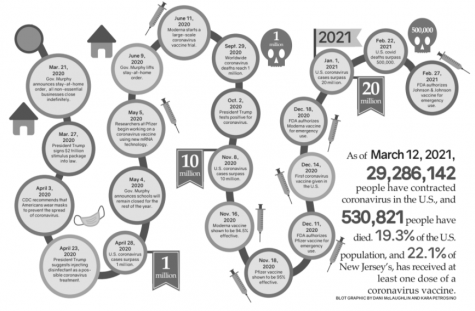Guidelines are necessary to help end the pandemic
January 19, 2021
On Thursday, Jan. 7, 4,194 people died from the coronavirus in the United States, surpassing 4,000 for the first time and setting a new record high. On Tuesday, Jan. 12, the United States beat that record, with 4,327 people dying from the coronavirus.
The COVID-19 pandemic is getting worse, not better. Dr. Anthony Fauci, the director of the National Institute of Allergy and Infectious Diseases, said that these alarming numbers are due to the recent holiday season.
“As we get into the next couple of weeks in January, that likely will be a reflection of the holiday season travel and the congregate settings that usually take place socially during that period of time,” Fauci said in an interview with NPR.
Fortunately, there is a light at the end of the tunnel. Highly effective vaccines made by Pfizer-BioNTech and Moderna have been authorized for emergency use by the Food and Drug Administration (FDA), and as of Jan. 13, over nine million people have been given a first vaccine dose, according to the Centers for Disease Control and Prevention (CDC).
Furthermore, President-elect Joe Biden, who will take office Jan. 20, plans to speed up vaccine distribution by immediately making all doses of the vaccine available instead of holding some back to be used as second doses. On Jan. 12, the outgoing Trump administration also announced that they would be starting this policy. Although this has caused some concerns on ensuring the availability of second doses within the recommended time frame, Biden is confident that this will not be an issue and believes this action is necessary in order to make good on his promise of delivering 100 million doses within his first 100 days in office.
While the situation is looking up, this doesn’t mean the rules and regulations currently in place go out the window. Even as doctors and professionals continue to discover new information about the virus and its spread, it’s crucial to continue practicing social distancing and mask-wearing.
With the recent holiday season, it is likely that we’ll see another spike in cases, hospitalizations and deaths, just as we did after Thanksgiving and Halloween. This has happened because of the disregard for the current government mandates, as families gathered close and unmasked for hours to celebrate.
Two weeks after Thanksgiving, Healthline reported that the number of cases went up 20%, the number of hospitalizations was up 21% and the number of deaths increased by 39%.
As of Jan. 13, the U.S. has confirmed over 22 million COVID-19 cases in total and total deaths surpassed 380,000. Experts at the Institute for Health Metrics and Evaluation predicted that by Apr. 1, the U.S. will exceed 560,000 deaths if these current trends continue.
The end of the pandemic will come with the establishment of herd immunity, where a significant portion of the population is immune to the virus and it therefore cannot spread as easily. Fauci told NPR it’s likely that 50% of people would have to get vaccinated before a clear impact is made, but it’ll take between 75 to 85% to establish herd immunity. He hopes that this process will begin in late March or early April, when the vaccines are expected to be distributed to the general public.
“Once we get there, if in the subsequent months, April, May, June, July, we get as many people vaccinated as possible, we could really turn this thing around before we get towards the end of the year,” Fauci told NPR.
We’re all tired of this “new normal” that we’ve been living with for almost a year now, but things are looking up. However, that doesn’t mean we disregard every other rule in place. If we continue wearing masks, social distancing and listening to the professionals in conjunction with the new vaccine administration, we can hopefully get back to regular life by this spring or summer while also reducing the amount of devastating fatalities.










